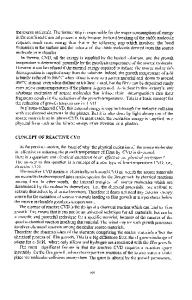Fabrication and Characterization of Polycrystalline Silicon Thin Films by Reactive Thermal CVD with Si 2 H 6 and F 2
- PDF / 654,945 Bytes
- 6 Pages / 612 x 792 pts (letter) Page_size
- 116 Downloads / 328 Views
Fabrication and Characterization of Polycrystalline Silicon Thin films by Reactive Thermal CVD with Si2H6 and F2
J. W. Lee, K. Shimizu, and J. Hanna Imaging Science and Engineering Lab., Tokyo Institute of Technology, Nagatsuta, Midori-ku, Yokohama, 226-8503, Japan
ABSTRACT Low-temperature growth of polycrystalline Silicon thin films has been investigated to fabricate thin film transistors by a new thermal CVD with the reactive source gases, Si2H6 and F2, resulting in the film growth at a low-temperature less than 500oC. In order to establish the optimal condition, gas pressure, total gas flow rate of Si2H6+F2 and He as a carrier gas, and residence time, τ, were tuned. Deposition rates and film crystallinity were influenced by the gas flow rations. The growth rate was 3.2-4.2[nm/min] and film uniformity was within ±6.5% over 4cm2 area. High crystallinity films showed a sharp peak at 520[cm-1] in Raman spectra whose full width at half maximum was 6-8[cm-1]. The high crystallinity even at the early stage of film growth was confirmed by transmission electron microscopy. The conductivity and activation energy is on the order of 10-5-10-6 [S/cm] and 0.53[eV], respectively, after hydrogenation. We fabricated poly-Si bottom-gate TFT that have field effect mobility as high as 32.3cm2/Vs and on/off current ratio of 104.
INTRODUCTION Recently, polycrystalline silicon (poly-Si) thin films have attracted a considerable attention as a large-area electronic material for devices applications such as thin film transistors for liquid crystal displays (AM-LCDs) and thin film solar cells [1]. These devices require the film uniformity over large-area and low-temperature processing lower than 500oC, where the low-cost glass substrate is available. Various low-temperature CVD techniques for preparing poly-Si films have been studied, e.g., plasma enhanced chemical vapor deposition (PECVD) [2], photo-CVD [3], and Hot-wire CVD [4]. However, in these techniques, there still remain problems for device fabrication such as large-area uniformity and film crystallinity at the early stage of the film growth. Thus, we have proposed a new CVD technique, i.e., Reactive Thermal Chemical Vapor Deposition (RTCVD), in which the film deposition takes place just like in the thermal CVD with the aid of heated substrate but the growth temperature can be lowered by decomposing the source gases through their chemical reactions in the vicinity of heated substrate [5]. In previous work, we prepared high crystallinity poly-SiGe films at 450oC through the redox reactions of the source materials, i.e., disilane (Si2H6) and germanium tetrafluoride (GeF4) [6-7]. Then, we selected disilane (Si2H6) and fluorine (F2) as the source materials in order to obtain pure poly-Si films instead of poly-SiGe thin films. In this paper, we will describe the preparation of poly-Si films using Si2H6 and F2 by A16.1.1 Downloaded from https://www.cambridge.org/core. HKUST Library, on 29 Oct 2018 at 01:25:01, subject to the Cambridge Core terms of use, available at https://www.cambri
Data Loading...








